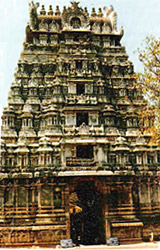 Tiruvalanchuzhi Temple is a vast temple but in a state of neglect. This temple is the 25th in the series of Tevara Stalams located south of the river Kaveri. Sweta Vinayakar - a white colored image of Ganapati - Sweta Vinayakar is the center of worship here.
Tiruvalanchuzhi Temple is a vast temple but in a state of neglect. This temple is the 25th in the series of Tevara Stalams located south of the river Kaveri. Sweta Vinayakar - a white colored image of Ganapati - Sweta Vinayakar is the center of worship here.
Legend: Gods fashioned the image out of foam generated from the ocean (Ksheera Samudram) during amrut manthan. Indra had this image in his possession after gaining immortality through Amritam. During his penance at Swamimalai, he set the image down at Tiruvalanchuzhi, after which it became rooted to the spot.
The Vinayakar shrine is found first as soon as you enter the temple complex. The intricate stone windows and delicately carved granite pillars. Durvasa muni carried out a yagnam here, and the gods who attended established several Siva Lingams here. Kaveri went into the ground, and when Heranda Muni went to retrieve her, it came back to the surface in this shrine, and completed a circle to the right, hence the name Valanchuzhi.
Temple: This temple covers over an area of eight acres, and has a huge tower on the entrance. There are shrines here dedicated to Brihannayaki (Periyanayaki), Subramanyar, Dakshinamurthy, Herandamuni, Aarumugar and others.
The temple is in a state of neglect but has interesting sculptures. Images of celestial nymphs and inscriptions reveal that Raja Raja Cholan made several endowments here. There are five mandapams here with intricately carved pillars and stucco images. Murals from the Nayaka period, and images depict the dance of Shiva during the Pradosha worship. The sculptures in the Valanchuzhi Vinayakar temple are beautiful. There are lavishly decorated pillars and niche deities here. The Ambal shrine is located to the right of Shiva shrine.
Festivals: Vinayaka Chaturthi, and a festival on the 6th day of the bright half of Margazhi (Sagittarius) are celebrated here. Festivities surround this temple in the Tamil month of Pankuni, when an image of Subramanya is taken in procession from Swamimalai to Tiruvalanchuzhi.





















